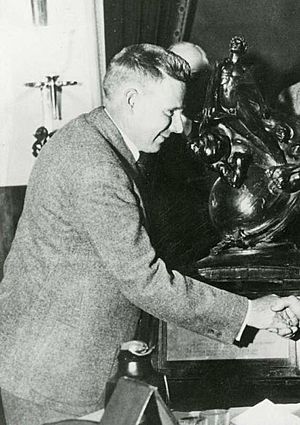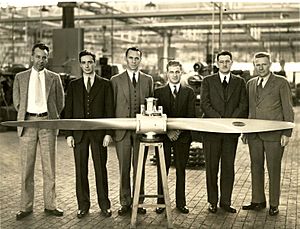Frank W. Caldwell facts for kids
Quick facts for kids
Frank W. Caldwell
|
|
|---|---|

Frank W. Caldwell being congratulated on winning the 1933 Collier Trophy (visible in the background) for his work with Hamilton Standard on the controllable-pitch propeller.
|
|
| Born | December 20, 1889 |
| Died | December 23, 1974 (aged 85) |
| Education | Mechanical engineering (B.S.) |
| Alma mater | University of Virginia Massachusetts Institute of Technology |
| Occupation | Aircraft propeller engineer |
| Known for | Variable-pitch propeller |
| Spouse(s) | Gertrude Sweigert Heisel Majorie Snodgrass |
| Children | Walter H. Caldwell (1924–2003) Frank W. A. Caldwell (1934–1962) |
| Parent(s) | Frank Hollis Caldwell Mary Ellis Nellie Walker |
| Awards | Collier Trophy (1933) Sylvanus Albert Reed Award (1935) |
Frank Walker Caldwell (1889–1974) was a very important American engineer who designed and improved propellers for airplanes. He was the main propeller engineer for the U.S. government from 1917 to 1928. During this time, he created new ways to test propellers and helped make them better.
Later, while working at Hamilton Standard Propeller Corporation, his team won the famous 1933 Collier Trophy. This award was for his amazing work on the controllable-pitch propeller, which changed how airplanes flew. He worked for 25 years and retired in 1955 from the United Aircraft Corporation Research Division.
Contents
Early Life and Education
Frank Caldwell was born in Lookout Mountain, Tennessee. His father was the president of a company and also the mayor of Chattanooga. Frank went to the Tome Preparatory School and the University of Virginia.
In 1912, he earned a degree in mechanical engineering from the Massachusetts Institute of Technology (MIT). Even though MIT didn't have aviation classes back then, Frank and a friend designed a glider that won a contest. His final project at MIT was even titled "Investigation of Air Propellers."
After college, he worked at Curtiss Aeroplane and Motor Company. In 1916, he helped solve a problem with airplane propellers falling apart in the heat of New Mexico. He invented a new type of glue that made propellers much more reliable.
Propeller Improvements During World War I
During World War I, Caldwell became the chief engineer for propeller research in the U.S. Army's Signal Corps. He worked at McCook Field and later Wilbur Wright Field. Here, he was in charge of developing all aircraft propellers.
In Ohio, Caldwell created the "whirl test." This test involved mounting a propeller on a fixed stand to measure its power, how long it could last, its speed, and how strong it was. This helped engineers understand and improve propeller designs.
After the war, propellers changed a lot. They went from being made of wood to metal. They also changed from having a fixed pitch (meaning the angle of the blades couldn't change) to having a variable pitch. Caldwell pushed for propellers with individual blades that could be adjusted. This meant that before a flight, pilots could set the blades for the best climb or the best cruising speed.
For example, Charles A. Lindbergh's famous plane, the Spirit of St. Louis, which flew solo across the Atlantic in 1927, used a propeller made by Standard Steel Propeller Company. Its pitch could only be adjusted on the ground.
Winning the 1933 Collier Trophy
In 1929, Caldwell started working at the Hamilton Standard Propeller Corporation. There, he continued to develop the controllable-pitch propeller. This invention was a huge step forward because it allowed airplanes to fly better by combining new engine power with less air resistance.
In 1933, the Boeing Model 247, one of the most advanced planes at the time, had trouble flying high. But after Hamilton Standard added Caldwell's hydraulic two-position controllable-pitch propeller, the plane could fly over the Rocky Mountains! The Douglas DC-2, another major airplane, also used Caldwell's invention.
Because of this important work, the 1933 Collier Trophy was given to "Hamilton Standard Aircraft Propeller Co, with special credit to Frank W Caldwell, Chief Engineer, for developing a controllable-pitch propeller." In June 1934, President Franklin D. Roosevelt even congratulated Caldwell in the Oval Office for this amazing achievement in aviation.
The Hydromatic Constant-Speed Propeller
Caldwell and Hamilton Standard didn't stop there. They also invented the automatic pitch-changing propeller, called the hydromatic constant-speed propeller. This propeller used hydraulic power (usually engine oil) to change the blade angle automatically. This kept the propeller spinning at a constant speed, which was very efficient.
This design also allowed pilots to "feather" a propeller blade. This meant turning the blade edge-on to the wind if an engine failed. This reduced drag and made the plane safer. This constant-speed propeller was so important that it was popularly known as the "gearshift of the air."
Almost all United States Army Air Forces planes used hydromatic constant-speed propellers during World War II. Caldwell and another engineer, Ernest G. McCauley, even held three joint patents for their propeller inventions. In 1990, the Hydromatic Propeller was recognized as an International Historic Mechanical Engineering Landmark.
Before Caldwell's hydraulic design, other engineers tried mechanical systems to change propeller pitch. But Caldwell's hydraulic design, fully developed by 1938, was much more successful. Hamilton Standard made 500,000 hydraulic controllable-pitch propellers for World War II airplanes.
Sylvanus Albert Reed Award (1935)
In 1935, Caldwell received the Sylvanus Albert Reed Award from the Institute of Aeronautical Sciences. This award is given for important research that helps develop practical aviation. He was also given an honorary fellowship by the Institute in 1946.
Family and Later Life
Frank Caldwell married Gertrude Sweigert Heisel in 1918, and they had a son named Walter. He later married Majorie Snodgrass, and they had a son named Frank.
Frank Caldwell passed away on December 23, 1974, at the age of 85. His inventions greatly changed aviation and helped planes fly faster, higher, and more safely.


